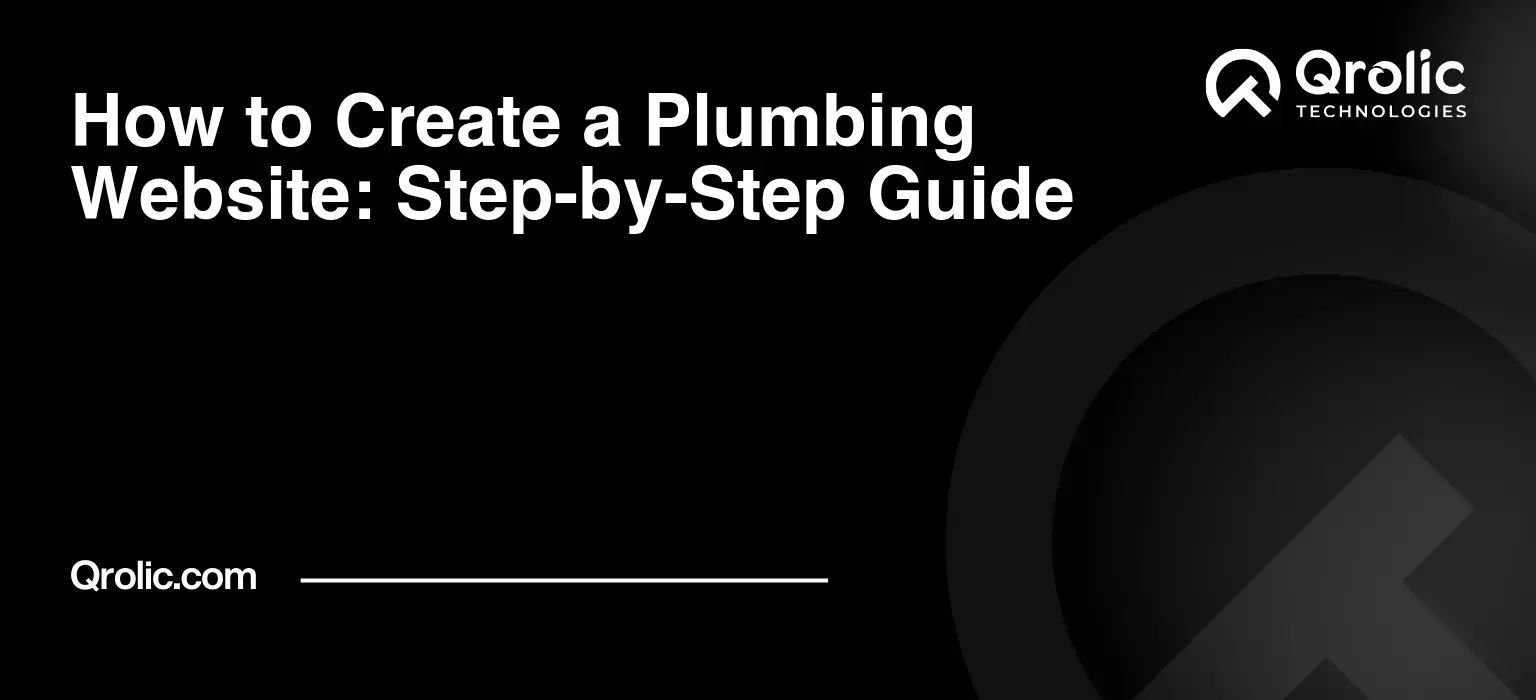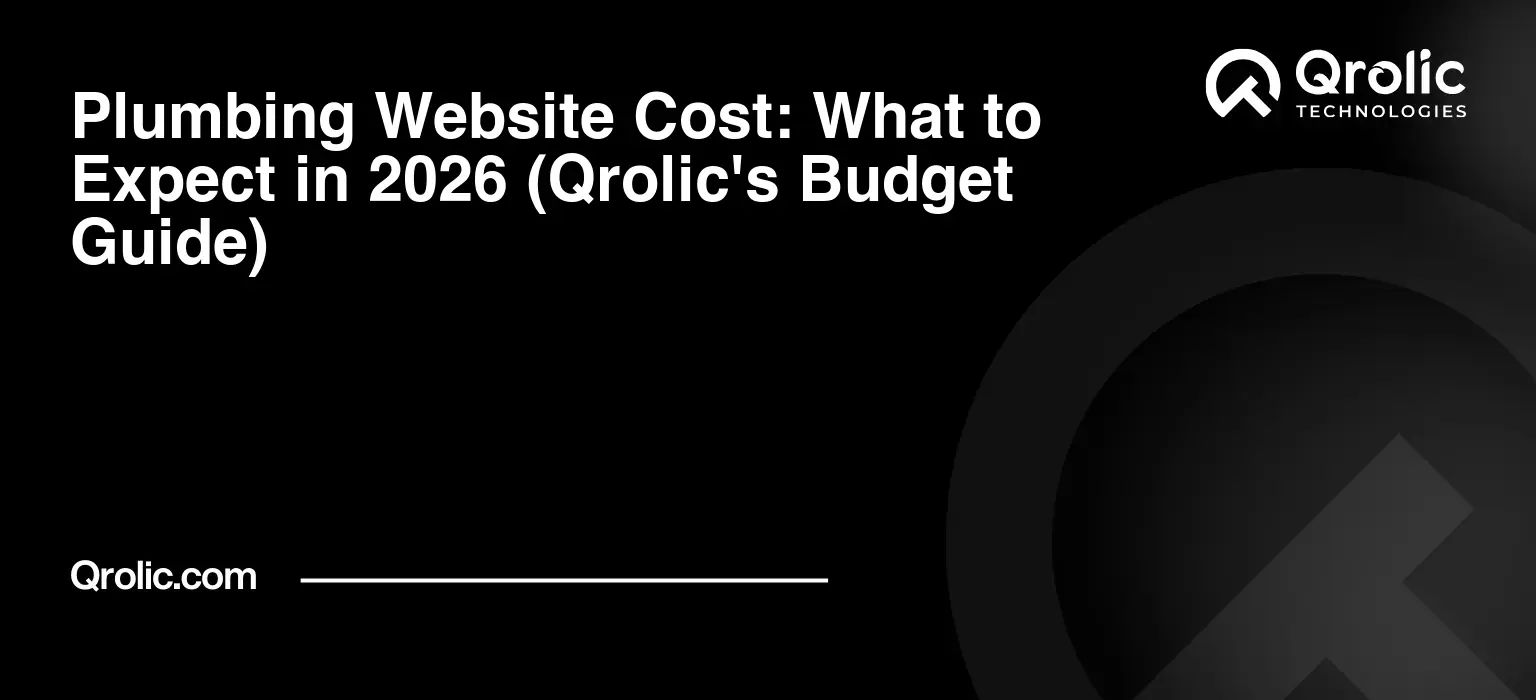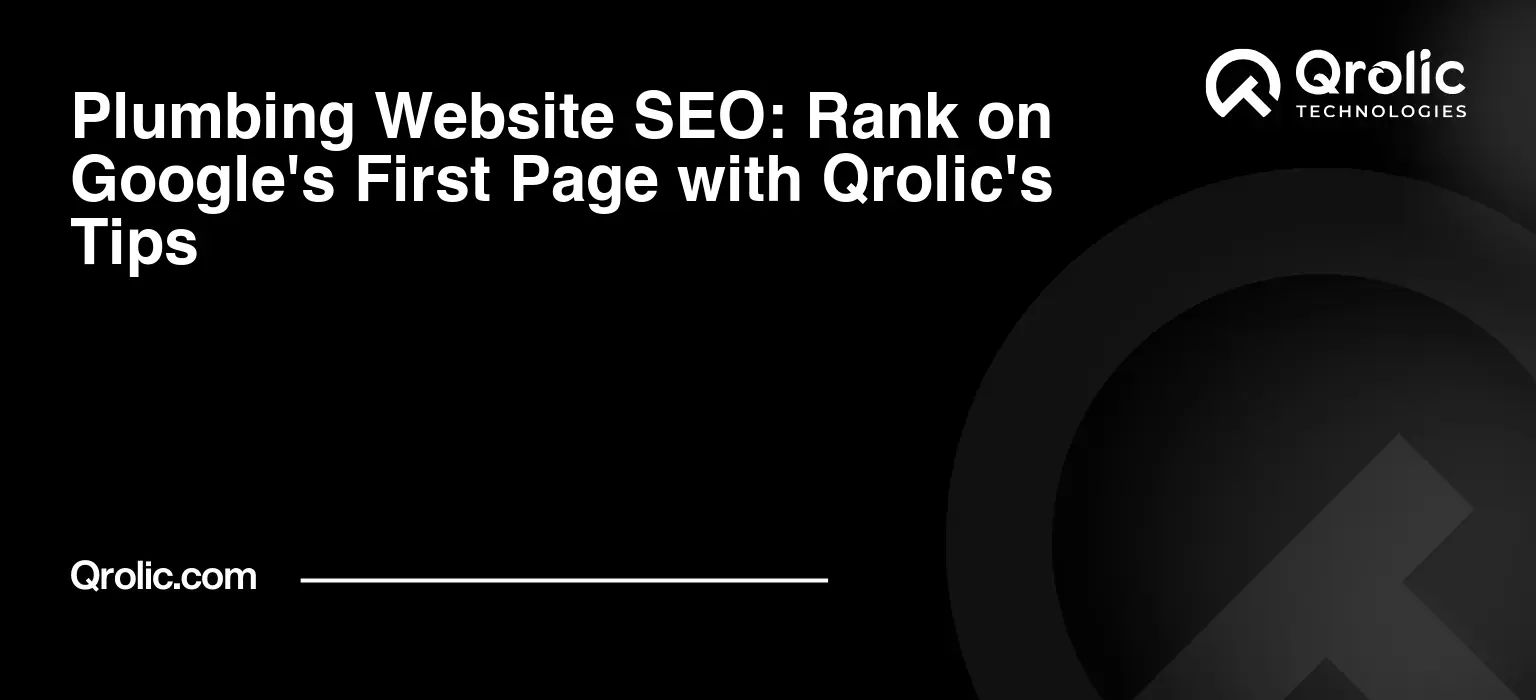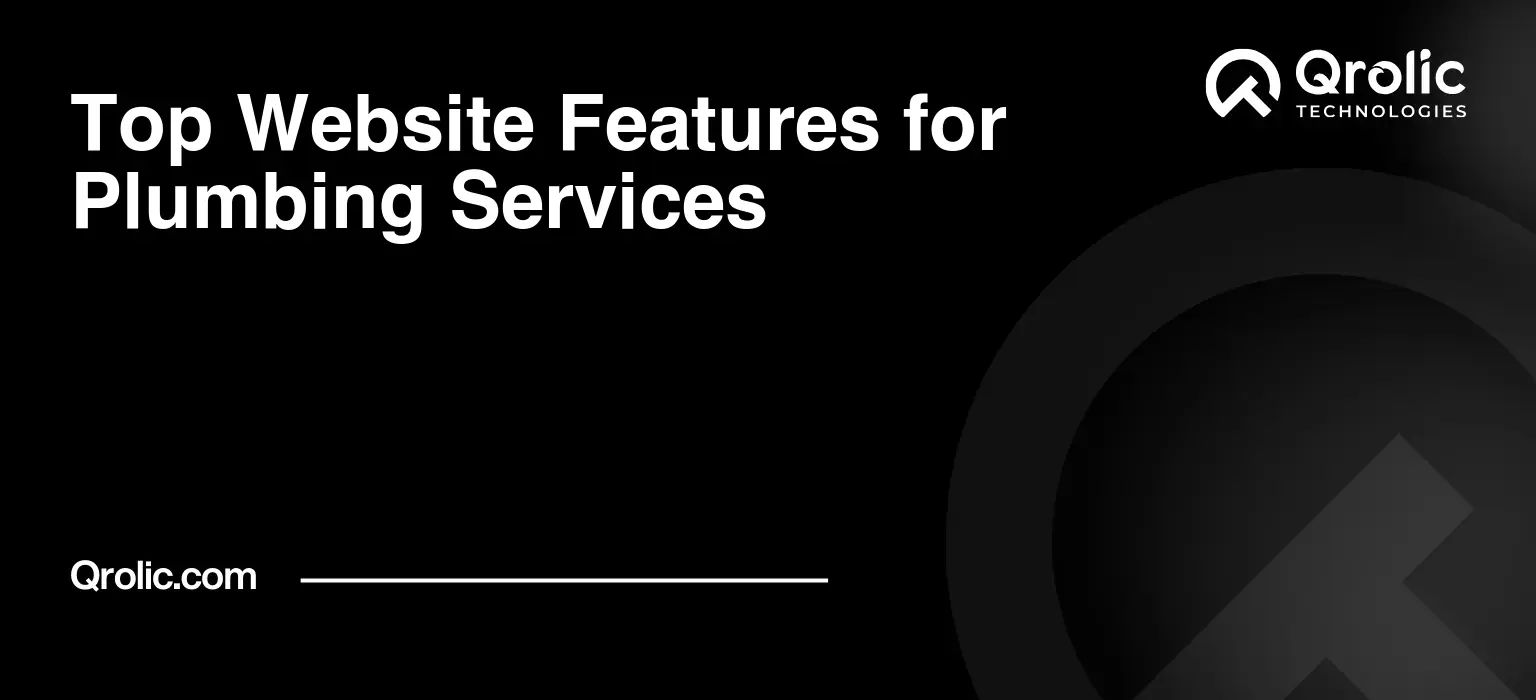Quick Summary:
- Your website is essential for attracting customers.
- Plan, design, and create great content.
- Optimize for search engines and ensure security.
- Promote and regularly update your site.
Table of Contents
- 1. Why Your Plumbing Business Needs a Website (Beyond the Yellow Pages)
- 2. Planning Your Plumbing Website: The Blueprint for Success
- 3. Choosing the Right Domain Name and Hosting for Your Plumbing Website
- 3.1 Domain Name Selection: Your Online Address
- 3.2 Web Hosting: Where Your Website Lives
- 4. Choosing a Website Platform: CMS vs. Custom Development
- 4.1 Content Management Systems (CMS): The User-Friendly Approach
- 4.2 Custom Development: The Tailored Solution
- 5. Plumbing Web Design: Creating a Visually Appealing and User-Friendly Website
- 5.1 Choosing a Theme or Template:
- 5.2 Essential Design Elements:
- 5.3 Branding Consistency:
- 6. Creating Compelling Content for Your Plumbing Website: Inform, Engage, and Convert
- 6.1 Essential Website Pages and Content:
- 6.2 Content Optimization Tips:
- 7. Search Engine Optimization (SEO) for Plumbers: Get Found Online
- 7.1 On-Page SEO:
- 7.2 Off-Page SEO:
- 7.3 Local SEO:
- 8. Website Security: Protecting Your Business and Customers
- 9. Tracking and Analytics: Measuring Your Website’s Performance
- 10. Promoting Your Plumbing Website: Getting the Word Out
- 11. Qrolic Technologies: Your Partner in Plumbing Web Design and Development
- Why Choose Qrolic Technologies?
- 12. Maintaining and Updating Your Plumbing Website: Keep it Fresh and Relevant
1. Why Your Plumbing Business Needs a Website (Beyond the Yellow Pages)

Forget dusty phone books! In today’s digital world, your plumbing website is your 24/7 salesperson, your digital storefront, and your primary source of new customers. It’s not just an option; it’s a necessity. But why exactly?
- Increased Visibility & Lead Generation: Potential customers are searching for “plumbing repair near me” or “emergency plumber” online. A well-optimized website ensures your business pops up in those search results, driving targeted traffic and generating qualified leads.
- Building Trust and Credibility: A professional website instantly lends credibility to your plumbing business. It demonstrates that you’re established, reliable, and invested in providing quality service. Think of it as your digital handshake.
- Showcasing Your Expertise: Your website is the perfect place to highlight your services, certifications, licenses, and years of experience. Use case studies, testimonials, and before-and-after photos to showcase your plumbing prowess.
- Providing Convenience for Customers: Customers can easily find your contact information, service areas, pricing (if you choose to display it), and even schedule appointments online – streamlining the entire process.
- Competitive Advantage: If your competitors have websites and you don’t, you’re already behind. A strong online presence allows you to compete effectively and capture a larger share of the market.
- Controlling Your Brand Narrative: Don’t let online reviews and social media be the only voices defining your brand. Your website allows you to craft your own story, highlight your values, and control the narrative around your business.
- Cost-Effective Marketing: Compared to traditional advertising methods like print ads and billboards, a website can be a much more cost-effective marketing tool, providing a higher ROI over time.
2. Planning Your Plumbing Website: The Blueprint for Success

Before diving into the technical aspects of plumbing web design, you need a solid plan. This stage is crucial for ensuring your website effectively achieves your business goals.
- Define Your Target Audience: Who are you trying to reach? Homeowners? Businesses? Property managers? Understanding your target audience will inform your design choices, content strategy, and overall marketing approach. Consider demographics, needs, and pain points.
- Set Clear Goals: What do you want your website to achieve? Generate leads? Schedule appointments? Provide information about your services? Define specific, measurable, achievable, relevant, and time-bound (SMART) goals.
- Map Out Your Website Structure (Sitemap): Create a sitemap, a visual representation of your website’s pages and their hierarchical relationship. This helps with navigation and ensures a logical flow for users. Common pages include:
- Homepage: The first impression – grab attention and clearly state your value proposition.
- About Us: Tell your story, highlight your experience, and build trust.
- Services: Detail all the plumbing services you offer.
- Service Areas: Specify the geographic areas you serve.
- Testimonials: Showcase positive reviews and build social proof.
- Blog: Share informative content and improve SEO.
- Contact Us: Provide easy ways for customers to reach you.
- Research Your Competitors: Analyze your competitors’ websites. What are they doing well? What could they improve? Identify opportunities to differentiate your business and offer a superior online experience.
- Consider Branding: Your website should reflect your brand identity. Use consistent colors, fonts, and imagery to create a cohesive and recognizable brand.
- Outline Your Content Strategy: Plan the content for each page of your website. What information will you provide? What keywords will you target? How will you engage visitors?
3. Choosing the Right Domain Name and Hosting for Your Plumbing Website
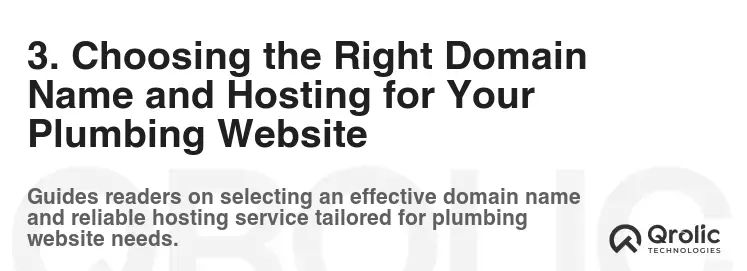
Your domain name and hosting are the foundation of your online presence. Select them carefully to ensure a smooth and reliable experience for your visitors.
3.1 Domain Name Selection: Your Online Address
- Keep it Short and Memorable: A shorter domain name is easier to remember and type.
- Use Relevant Keywords: Include keywords related to plumbing, such as “plumbing,” “repair,” or your city/region. For example, “YourCityPlumbing.com”.
- Choose the Right Extension: “.com” is the most common and recognizable extension. Other options include “.net,” “.org,” or country-specific extensions.
- Check Availability: Use a domain name registrar (e.g., GoDaddy, Namecheap) to check if your desired domain name is available.
- Avoid Hyphens and Numbers: They can be difficult to remember and communicate verbally.
- Consider Your Brand Name: If possible, use your business name as your domain name for consistency.
- Secure Variations: If your primary domain is available in different extensions (.net, .org), consider purchasing them to prevent competitors from using similar names.
3.2 Web Hosting: Where Your Website Lives
- Understand Your Hosting Needs: Consider factors such as website size, traffic volume, and technical requirements when choosing a hosting plan.
- Shared Hosting: A cost-effective option for small websites with low traffic. Your website shares server resources with other websites.
- VPS Hosting (Virtual Private Server): Offers more resources and control than shared hosting. Your website has its own virtual server, providing better performance and security.
- Dedicated Hosting: The most expensive option, offering the highest level of resources and control. You have an entire server dedicated to your website.
- wordpress Hosting: Optimized for WordPress websites, providing features like automatic updates and security enhancements.
- Evaluate Hosting Providers: Research different hosting providers and compare their features, pricing, and customer support. Popular options include Bluehost, SiteGround, and HostGator.
- Consider Uptime and Reliability: Choose a hosting provider with a high uptime guarantee to ensure your website is available to visitors.
- Check for Scalability: Ensure your hosting plan can accommodate future growth in traffic and website size.
- Review Customer Support: Choose a hosting provider with responsive and helpful customer support in case you encounter any issues.
4. Choosing a Website Platform: CMS vs. Custom Development
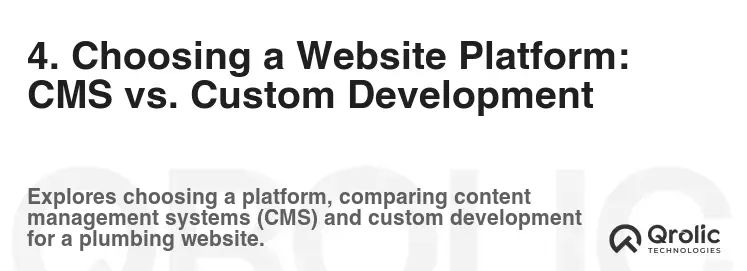
You have two primary options for building your plumbing website: using a content management system (CMS) or opting for custom development.
4.1 Content Management Systems (CMS): The User-Friendly Approach
A CMS is a software application that allows you to create, manage, and modify website content without requiring extensive technical knowledge.
- WordPress: The most popular CMS, offering a vast library of themes and plugins, making it highly customizable and user-friendly. Ideal for most plumbing businesses.
- Squarespace: A user-friendly platform with drag-and-drop functionality, perfect for beginners.
- Wix: Another drag-and-drop website builder, offering a wide range of templates and features.
- Pros of Using a CMS:
- Ease of Use: No coding skills required.
- Cost-Effective: Generally less expensive than custom development.
- Customizable: Themes and plugins allow you to tailor the design and functionality to your needs.
- SEO-Friendly: CMS platforms are often optimized for search engines.
- Large Community Support: Access to a vast community of users and developers for support and resources.
- Cons of Using a CMS:
- Security Vulnerabilities: Plugins and themes can introduce security risks if not properly maintained.
- Limited Customization: While customizable, CMS platforms may have limitations compared to custom development.
- Reliance on Plugins: Over-reliance on plugins can slow down your website and create compatibility issues.
4.2 Custom Development: The Tailored Solution
Custom website development involves building a website from scratch, using programming languages like HTML, CSS, JavaScript, and server-side languages like PHP or Python.
- Pros of Custom Development:
- Complete Control: You have full control over the design, functionality, and performance of your website.
- Unique Design: Create a website that is completely unique and tailored to your specific brand.
- Scalability: Easily scale your website to accommodate future growth and changing needs.
- Optimized Performance: Optimize your website for speed and performance.
- Cons of Custom Development:
- High Cost: Custom development is significantly more expensive than using a CMS.
- Time-Consuming: Building a website from scratch takes more time and effort.
- Requires Technical Expertise: You need to hire experienced web developers.
- Maintenance and Updates: You are responsible for maintaining and updating your website.
For most plumbing businesses, WordPress is the recommended option due to its ease of use, cost-effectiveness, and extensive customization options.
5. Plumbing Web Design: Creating a Visually Appealing and User-Friendly Website
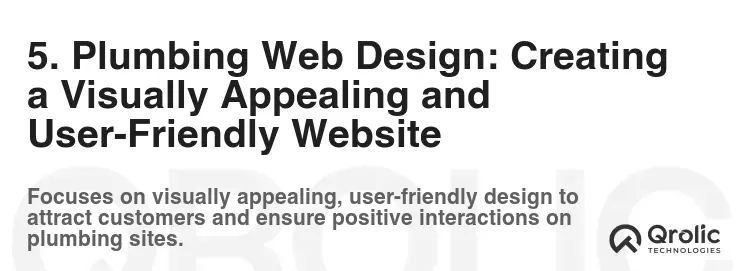
Your website’s design is crucial for attracting and retaining visitors. It should be visually appealing, user-friendly, and optimized for conversions.
5.1 Choosing a Theme or Template:
- WordPress Themes: Explore the WordPress theme directory or premium theme marketplaces like ThemeForest. Look for themes specifically designed for service businesses or those that offer customization options suitable for the plumbing industry.
- Key Considerations:
- Responsiveness: Ensure the theme is responsive and looks great on all devices (desktops, tablets, and smartphones).
- Clean and Professional Design: Choose a theme with a clean and professional design that reflects your brand.
- Easy to Customize: Select a theme that is easy to customize without requiring extensive coding knowledge.
- SEO Optimization: Look for themes that are optimized for search engines.
- Fast Loading Speed: Choose a theme that is lightweight and loads quickly.
- Positive Reviews: Read reviews from other users before selecting a theme.
5.2 Essential Design Elements:
- Clear and Concise Navigation: Make it easy for visitors to find what they’re looking for with a clear and intuitive navigation menu.
- High-Quality Images and Videos: Use high-quality images and videos to showcase your work and services. Before-and-after photos are especially effective.
- Compelling Headlines and Copy: Use compelling headlines and persuasive copy to capture attention and communicate your value proposition.
- Call-to-Action Buttons: Use prominent call-to-action buttons (e.g., “Get a Free Quote,” “Schedule an Appointment”) to guide visitors towards desired actions.
- Contact Information: Make your contact information easily accessible on every page of your website.
- Service Area Map: Embed a map showing your service areas to help visitors determine if you serve their location.
- Testimonials and Reviews: Display testimonials and reviews from satisfied customers to build trust and credibility.
- Mobile-First Design: Prioritize the mobile experience, as many users will access your website on their smartphones.
- Accessibility: Ensure your website is accessible to people with disabilities by following accessibility guidelines (WCAG).
5.3 Branding Consistency:
- Color Palette: Use a consistent color palette that reflects your brand identity.
- Fonts: Choose fonts that are easy to read and consistent with your brand.
- Logo: Display your logo prominently on every page of your website.
6. Creating Compelling Content for Your Plumbing Website: Inform, Engage, and Convert
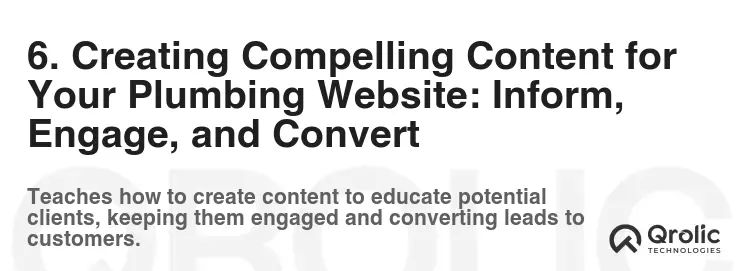
Content is king! Your website’s content should be informative, engaging, and optimized for search engines.
6.1 Essential Website Pages and Content:
- Homepage:
- Headline: A clear and concise headline that communicates your value proposition.
- Subheadline: A supporting subheadline that elaborates on your headline.
- Call-to-Action: A prominent call-to-action button (e.g., “Get a Free Quote,” “Schedule an Appointment”).
- Brief Overview of Services: Highlight your key plumbing services.
- Testimonials: Include a few testimonials from satisfied customers.
- High-Quality Images: Use relevant and visually appealing images.
- About Us:
- Your Story: Tell the story of your plumbing business.
- Your Mission and Values: Highlight your mission and values.
- Your Experience and Expertise: Showcase your years of experience and expertise.
- Meet the Team: Introduce your team members (optional).
- Licenses and Certifications: Display your licenses and certifications.
- Services:
- Detailed Descriptions: Provide detailed descriptions of each plumbing service you offer.
- Benefits of Each Service: Explain the benefits of each service.
- Pricing (Optional): Display pricing information (optional).
- Call-to-Action: Include a call-to-action button for each service (e.g., “Learn More,” “Get a Quote”).
- Images: Use images to illustrate each service.
- Service Areas:
- List of Service Areas: Clearly list the geographic areas you serve.
- Map: Embed a map showing your service areas.
- Testimonials:
- Authentic Testimonials: Gather authentic testimonials from satisfied customers.
- Photos (Optional): Include photos of your customers (with their permission).
- Blog:
- Informative Articles: Publish informative articles related to plumbing, such as “How to Prevent Clogged Drains,” “Tips for Saving Water,” or “Signs You Need a New Water Heater.”
- Keyword Optimization: Optimize your blog posts for relevant keywords.
- Engaging Content: Write engaging and easy-to-understand content.
- Contact Us:
- Contact Form: Include a contact form for visitors to submit inquiries.
- Phone Number: Display your phone number prominently.
- Email Address: Provide your email address.
- Address: Include your business address.
- Social Media Links: Link to your social media profiles.
- Map: Embed a map showing your location.
6.2 Content Optimization Tips:
- Keyword Research: Identify the keywords that your target audience is searching for. Use tools like Google Keyword Planner or SEMrush.
- Keyword Integration: Incorporate relevant keywords into your website content, including headlines, subheadings, and body text.
- Write for Your Audience: Write in a clear and concise style that is easy to understand. Avoid technical jargon.
- Use Headings and Subheadings: Break up your content with headings and subheadings to improve readability.
- Use Images and Videos: Include images and videos to enhance your content and engage visitors.
- Proofread Your Content: Proofread your content carefully for spelling and grammar errors.
7. Search Engine Optimization (SEO) for Plumbers: Get Found Online
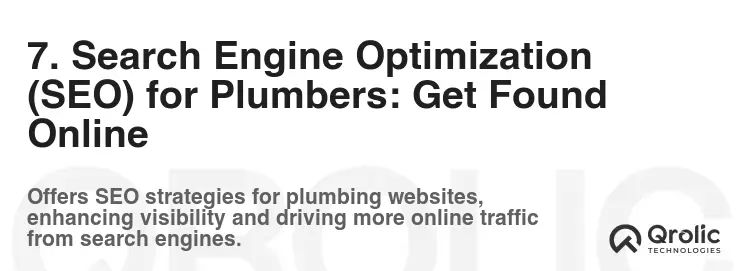
SEO is the process of optimizing your website to rank higher in search engine results pages (SERPs). This is crucial for driving organic traffic and generating leads.
7.1 On-Page SEO:
- Keyword Research and Targeting: As mentioned earlier, identify and target relevant keywords.
- Title Tags: Optimize your title tags with relevant keywords. Keep them under 60 characters.
- Meta Descriptions: Write compelling meta descriptions that entice users to click on your website. Keep them under 160 characters.
- Header Tags (H1-H6): Use header tags to structure your content and incorporate relevant keywords.
- Image Alt Text: Add alt text to your images, describing what the image is about and including relevant keywords.
- Internal Linking: Link to other relevant pages on your website.
- Mobile-Friendliness: Ensure your website is mobile-friendly.
- Page Speed Optimization: Optimize your website for speed by compressing images, using a caching plugin, and choosing a fast hosting provider.
- Schema Markup: Implement schema markup to provide search engines with more information about your business, services, and location. This can enhance your search engine results and improve click-through rates.
7.2 Off-Page SEO:
- Link Building: Build high-quality backlinks from other reputable websites in your industry.
- Local Citations: List your business in online directories, such as Yelp, Google My Business, and Angie’s List. Ensure your NAP (Name, Address, Phone number) information is consistent across all citations.
- Social Media Marketing: Promote your website and content on social media platforms.
- Online Reviews: Encourage customers to leave reviews on your Google My Business profile and other review sites.
7.3 Local SEO:
- Google My Business (GMB) Optimization: Claim and optimize your Google My Business profile.
- NAP Consistency: Ensure your NAP information is consistent across all online platforms.
- Local Keyword Targeting: Target local keywords in your website content and SEO efforts.
- Local Citations: Build citations in local directories and websites.
8. Website Security: Protecting Your Business and Customers

Website security is paramount for protecting your business and your customers’ data.
- SSL Certificate: Install an SSL certificate to encrypt data transmitted between your website and visitors.
- Strong Passwords: Use strong passwords for your website admin account and hosting account.
- Regular Backups: Create regular backups of your website to protect against data loss.
- Security Plugins: Install security plugins to protect against malware, hacking attempts, and other security threats.
- Software Updates: Keep your CMS, themes, and plugins up-to-date to patch security vulnerabilities.
- Firewall: Implement a firewall to block malicious traffic.
- Two-Factor Authentication: Enable two-factor authentication for your website admin account.
- Limit Login Attempts: Limit the number of failed login attempts to prevent brute-force attacks.
9. Tracking and Analytics: Measuring Your Website’s Performance
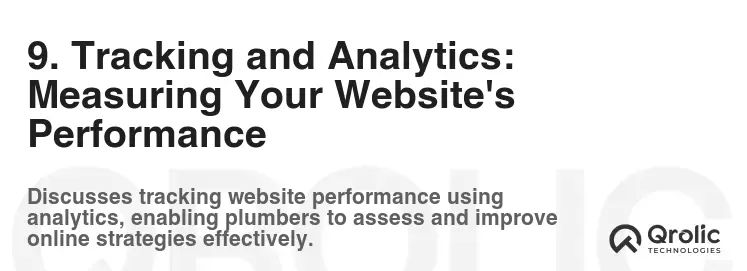
Tracking and analytics are essential for understanding your website’s performance and making data-driven decisions.
- Google Analytics: Install Google Analytics to track website traffic, user behavior, and conversions.
- Key Metrics to Track:
- Traffic: Track the number of visitors to your website.
- Bounce Rate: Track the percentage of visitors who leave your website after viewing only one page.
- Time on Site: Track the average amount of time visitors spend on your website.
- Conversion Rate: Track the percentage of visitors who complete a desired action, such as submitting a contact form or scheduling an appointment.
- Keyword Rankings: Track your website’s rankings for relevant keywords.
- Set Up Goals: Set up goals in Google Analytics to track specific conversions, such as contact form submissions or phone calls.
- Analyze Data: Regularly analyze your website’s data to identify areas for improvement.
10. Promoting Your Plumbing Website: Getting the Word Out

Building a great website is only half the battle. You also need to promote it to attract visitors and generate leads.
- Search Engine Optimization (SEO): Continue to optimize your website for search engines.
- Social Media Marketing: Promote your website and content on social media platforms.
- Email Marketing: Build an email list and send out regular newsletters to promote your services and website.
- Pay-Per-Click (PPC) Advertising: Run PPC campaigns on Google Ads or other platforms to drive targeted traffic to your website.
- Local Advertising: Advertise your website in local newspapers, magazines, and radio stations.
- Networking: Attend local networking events to promote your business and website.
- Partnerships: Partner with other local businesses to cross-promote each other’s websites.
- Content Marketing: Create valuable content that attracts and engages your target audience.
11. Qrolic Technologies: Your Partner in Plumbing Web Design and Development

Creating and managing a successful plumbing website can be challenging. That’s where Qrolic Technologies comes in. We are a leading digital marketing agency specializing in website design, SEO, and online marketing for businesses like yours.
- Website Design Services: We design stunning, user-friendly websites that are optimized for conversions. Our team of experienced web designers will work with you to create a website that reflects your brand and meets your business goals. We focus on creating websites that are not just visually appealing but also functionally effective, ensuring a seamless user experience.
- SEO Services: We’ll help you rank higher in search engine results pages (SERPs) with our comprehensive SEO services. Our SEO experts will conduct keyword research, optimize your website content, build high-quality backlinks, and implement other strategies to improve your online visibility. We stay up-to-date with the latest SEO trends and algorithm updates to ensure that your website remains competitive.
- Social Media Marketing: We’ll help you build a strong social media presence and engage with your target audience. Our social media experts will create engaging content, manage your social media accounts, and run social media advertising campaigns. We tailor our social media strategies to align with your brand and business objectives.
- Content Marketing: We can create valuable content that attracts and engages your target audience. Our content writers will write blog posts, articles, website copy, and other content that is optimized for search engines and designed to convert visitors into customers. We develop content calendars to ensure a consistent flow of high-quality content that keeps your audience engaged.
Why Choose Qrolic Technologies?
- Expertise: We have a team of experienced web designers, SEO experts, PPC specialists, social media marketers, and content writers.
- Results-Driven: We are committed to delivering results and helping our clients achieve their business goals.
- Customer-Focused: We are dedicated to providing exceptional customer service.
- Affordable Pricing: We offer competitive pricing plans to fit your budget.
12. Maintaining and Updating Your Plumbing Website: Keep it Fresh and Relevant
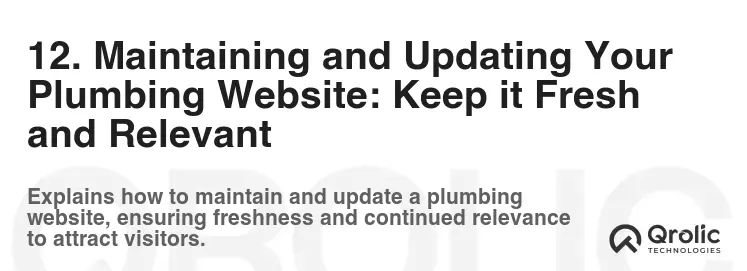
Your website is not a “set it and forget it” project. It requires ongoing maintenance and updates to stay fresh, relevant, and secure.
- Regular Content Updates: Add new blog posts, update service descriptions, and refresh your website content regularly.
- Software Updates: Keep your CMS, themes, and plugins up-to-date.
- Security Monitoring: Monitor your website for security threats and vulnerabilities.
- Performance Monitoring: Monitor your website’s performance and identify areas for improvement.
- Backup Your Website: Regularly back up your website to protect against data loss.
- Check for Broken Links: Check for broken links and fix them promptly.
- Test Your Website on Different Devices: Test your website on different devices and browsers to ensure it is working properly.
- Analyze Your Website’s Data: Regularly analyze your website’s data to identify areas for improvement.
- Stay Up-to-Date on Industry Trends: Stay up-to-date on the latest trends in web design, SEO, and online marketing.
By following this step-by-step guide, you can create a plumbing website that attracts customers, generates leads, and helps your business thrive in the digital age. Don’t hesitate to reach out to Qrolic Technologies for assistance with any aspect of your website design or digital marketing needs. We are here to help you succeed!
